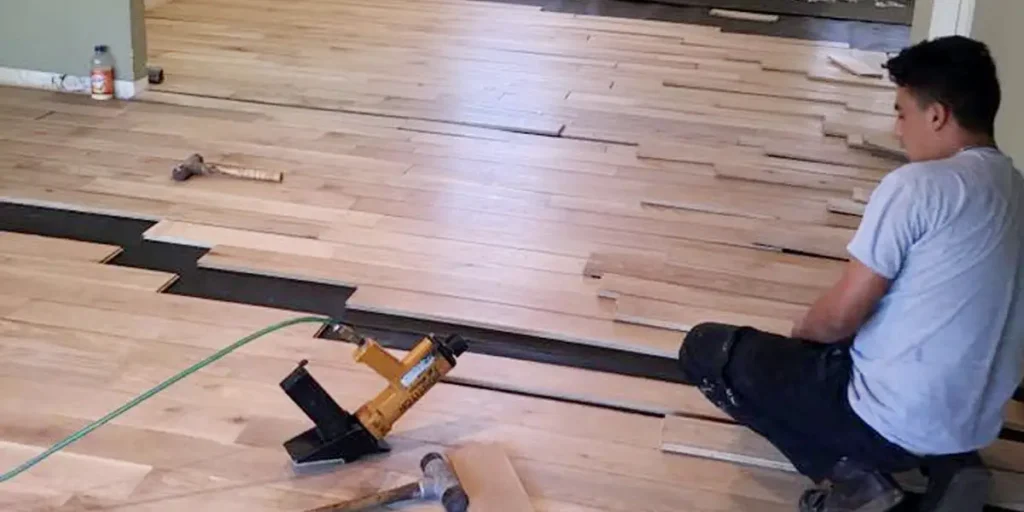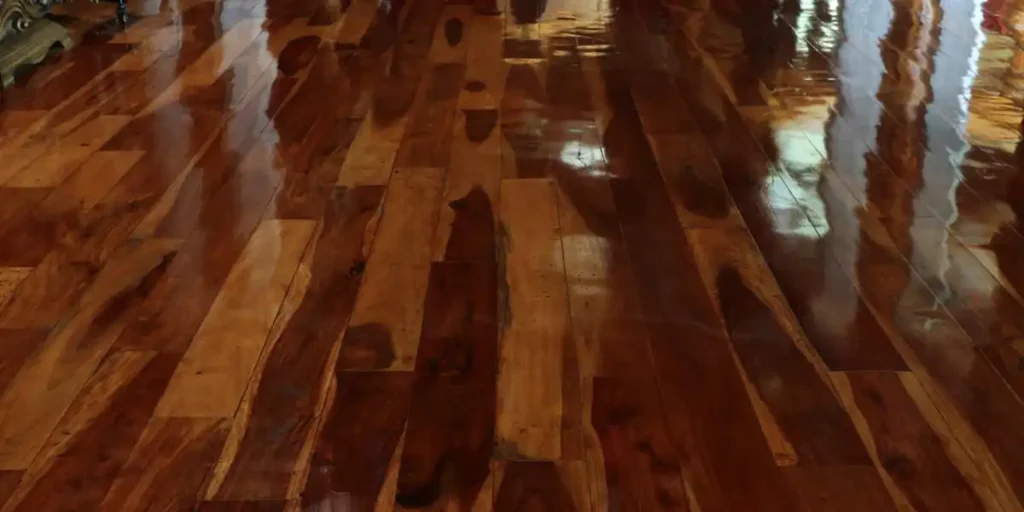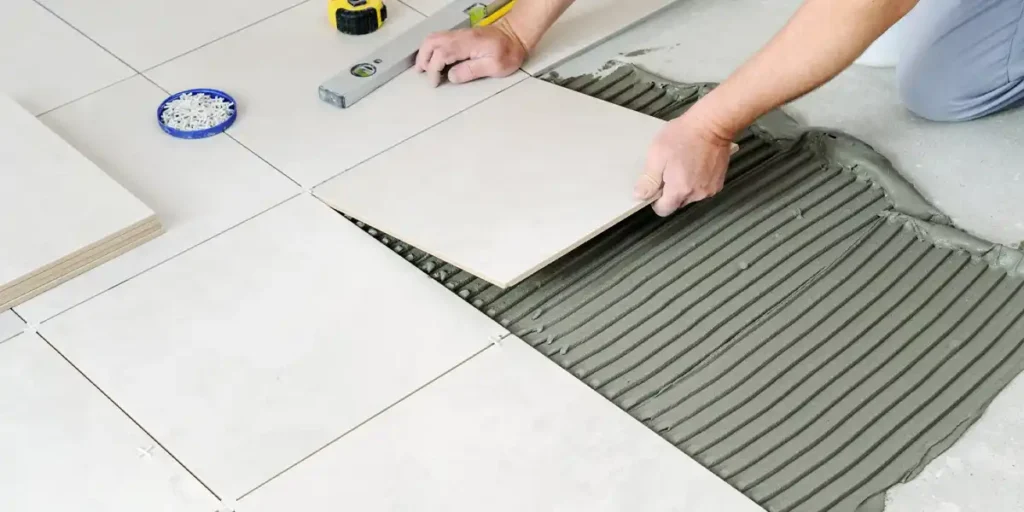Concrete floors are durable and practical but lack the warmth and character that laminate flooring brings. Installing laminate on concrete is an excellent way to upgrade your space, but it’s not without challenges.
From ensuring the subfloor is level and moisture-proof to laying each plank correctly, the process requires meticulous attention to detail. Don’t worry.
This guide will walk you through every step, ensuring a seamless transition from cold concrete to cozy laminate.
Preparing the Concrete Subfloor: The Key to Success
Proper preparation is the foundation of a successful laminate flooring installation. Skipping or rushing this step can lead to uneven surfaces, squeaks, and long-term damage.
Follow these essential steps:
1. Assessing Your Concrete Subfloor
Begin with a thorough inspection of the concrete:
- Check for Imperfections: Look for cracks, holes, or bumps.
- Test for Levelness: Use a level to ensure the floor is even. Variations greater than 1/8 inch over 6 feet require attention.
- Assess Structural Integrity: Ensure the subfloor can support the laminate flooring.
2. Cleaning and Repairing
Cleanliness is vital:
- Vacuum and Sweep Thoroughly: Remove all dirt and debris.
- Patch Cracks: Use a concrete patching compound to fill gaps and holes. Allow adequate drying time.
- Remove Residues: Any adhesive or sealant left from previous installations must be cleared.
3. Moisture Control
Concrete is porous and prone to moisture, which can warp laminate flooring.
- Test Moisture Levels: Use a moisture meter to check humidity. If levels are too high, delay the installation.
- Install a Vapor Barrier: Lay polyethylene sheeting to block moisture from seeping into the laminate. Tape seams securely.
Installing the Underlayment: Cushioning and Protection
Underlayment is crucial for noise reduction, cushioning, and moisture protection.
1. Choosing the Right Underlayment
Select an underlayment designed for concrete. Foam underlayments with vapor barriers work best for moisture-prone environments.
2. Installing the Underlayment
- Measure and Cut: Roll out the underlayment and cut it to fit the room dimensions.
- Lay Smoothly: Avoid overlapping and ensure a flat surface. Tape seams with vapor-resistant tape.
- Secure the Edges: Attach the underlayment snugly against walls to prevent shifting during laminate installation.
Installing the Laminate: Putting It All Together
Now the fun begins! Here’s how to install laminate flooring on concrete:
1. Acclimate the Planks
Allow the laminate to sit in the room for 48 hours to adjust to temperature and humidity. This step prevents post-installation expansion or contraction.
2. Starting Point
- Choose a Starting Wall: Begin along the longest, straightest wall.
- Use Spacers: Maintain a 1/4-inch gap between the planks and the wall to accommodate expansion.
3. Laying the Planks
- Click-Lock System: Gently tap planks together using a tapping block and mallet. Avoid damaging the edges.
- Stagger Seams: Offset the seams in each row for structural integrity and visual appeal.
- Precision Cuts: Use a laminate cutter or fine-tooth saw for clean cuts around obstacles.
4. Final Touches
- Install Baseboards and Trim: Cover the expansion gaps for a polished look.
- Add Transition Strips: Seamlessly transition between laminate and adjacent flooring.
Troubleshooting Common Problems: Effective Solutions
Even with meticulous planning, unforeseen challenges can arise during or after installing laminate flooring. Identifying and addressing these issues promptly is crucial for maintaining the integrity and appearance of your flooring.
Here’s how to resolve some common problems effectively:
Uneven Subfloor
An uneven subfloor is one of the most common causes of creaking, shifting, or uneven laminate surfaces. If this occurs, it indicates that the subfloor wasn’t adequately leveled before installation. To fix this:
- Lift the Affected Planks: Carefully remove the planks in the problematic area without damaging them.
- Level the Subfloor: Apply a self-leveling compound to the uneven sections. Follow the manufacturer’s instructions for drying time and ensure a completely smooth surface.
- Reinstall the Planks: Once the compound is set and dry, reinstall the laminate planks, ensuring they fit securely.
Moisture Issues
Warping, buckling, or swelling of laminate flooring often signals moisture problems. This can happen if the vapor barrier wasn’t installed correctly or if moisture has seeped in due to leaks. Here’s what to do:
- Inspect for Leaks: Identify and fix any water source, such as leaks from pipes or appliances.
- Check the Vapor Barrier: Ensure that the moisture barrier is intact and properly sealed. If compromised, replace it in the affected area.
- Dry the Floor: Use dehumidifiers and fans to dry the area before reinstalling the laminate.
Gaps Between Planks
Gaps between planks can result from improper fitting during installation or inadequate acclimation of the flooring. To address this:
- Dismantle the Affected Planks: Remove the planks in the area with gaps.
- Reinstall Securely: Reinstall the planks, ensuring a snug fit and using spacers for consistent alignment.
- Acclimation Matters: Before reinstalling, ensure the planks have acclimated to the room’s temperature and humidity to minimize expansion or contraction.
By addressing these issues proactively and carefully, you can preserve the durability and aesthetics of your laminate flooring, ensuring a smooth and lasting installation.
Wrapping It Up
Installing laminate flooring on concrete is a rewarding project that enhances your home’s beauty and functionality. With meticulous preparation, the right materials, and a little patience, you can achieve professional-looking results.
Enjoy the warmth, style, and durability of your new laminate flooring, and take pride in the fact that you did it yourself!
Transform your concrete floors with expert laminate flooring installation! Trust Cardenas Flooring for precision, durability, and a flawless finish. Contact us today for a free quote!
FAQs
Can laminate flooring be installed directly on concrete?
Yes, laminate flooring can be installed on concrete, but proper preparation is critical. Clean the surface thoroughly, repair any cracks, and ensure it’s level. Additionally, test for moisture levels and install a vapor barrier to prevent moisture from damaging the flooring. Skipping these steps can lead to uneven surfaces, buckling, or other issues that compromise the floor’s longevity.
How long does it take to install laminate flooring on concrete?
The time required depends on the size of the room, your experience level, and the condition of the subfloor. Preparing the concrete can take 1-2 days, and the installation itself may take another 1-3 days. Allow extra time for acclimating the planks to the room’s temperature and humidity to avoid post-installation expansion or contraction issues.
Do I need a vapor barrier when installing laminate flooring on concrete?
Yes, a vapor barrier is essential when installing laminate over concrete. Concrete naturally retains moisture, which can seep into the laminate and cause warping or buckling. A polyethylene vapor barrier provides effective moisture protection, ensuring the durability and stability of your laminate flooring over time.
What type of underlayment is best for concrete subfloors?
Foam underlayment with a built-in moisture barrier is ideal for concrete subfloors. It offers moisture protection, sound insulation, and cushioning. Ensure the underlayment is specifically designed for concrete to address potential moisture and ensure a smooth installation.
How do I prevent gaps or buckling after installation?
Prevent gaps or buckling by allowing the laminate planks to acclimate to the room’s temperature and humidity for at least 48 hours before installation. Maintain a consistent expansion gap around the edges of the room and ensure the subfloor is level. Proper installation techniques and using spacers can also help achieve a secure fit.




